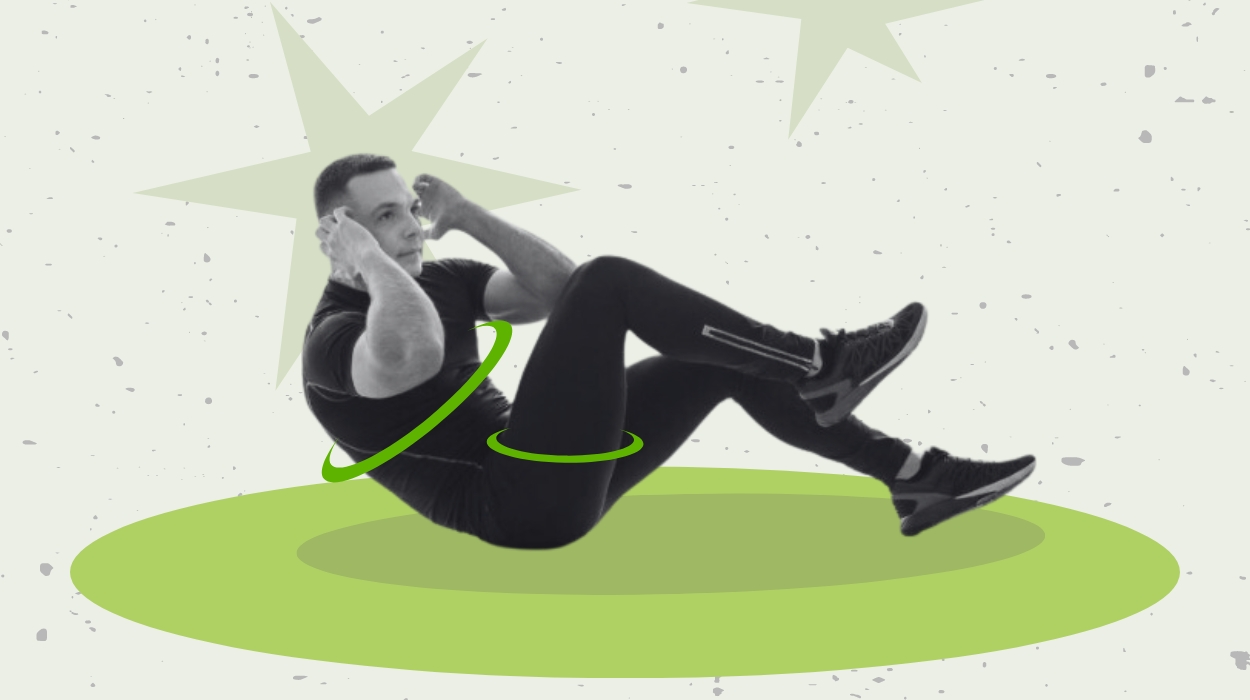
Looking to strengthen your core and burn fat? Look no further than deep core exercises. These core workouts target the muscles deep within your abdomen, including the transverse abdominis and pelvic floor muscles.
These exercises will help tone and strengthen your core while also contributing to improved posture and enhanced stability. Exercising your deep core can also help you lose weight, especially when combined with a good fat burner.
This guide will explore ten effective deep core exercises to try now, along with their step-by-step instructions and suggested repetitions.
Deep Core Workout: Best Deep Core Exercises To Strengthen Your Muscles
These ten deep core exercises will help you strengthen and stabilize your core:
Best Deep Core Exercises For Deep Core Muscles
Plank
The Plank is a classic core exercise that engages your entire midsection, helping you build a strong core foundation. It can be done anywhere and improves your posture, balance, and stability.

How to do:
- Start in a push-up position with your forearms on the ground.
- Keep your body in a straight line from head to heels, engaging your core.
- Hold this position for 30 to 60 seconds, depending on your fitness level.
Tips:
- Keep your body in a straight line from head to heels to engage your deep core muscles effectively.
- Breathe steadily and avoid holding your breath to maintain core stability.
- Avoid arching your back or sagging your hips to prevent strain and maximize the benefits of the exercise.
Optimal Sets and Reps: three sets of 30-60 seconds.
Dead Bug
The Dead Bug exercise challenges your core stability while protecting your lower back. It uses every muscle in your core for a cohesive workout.
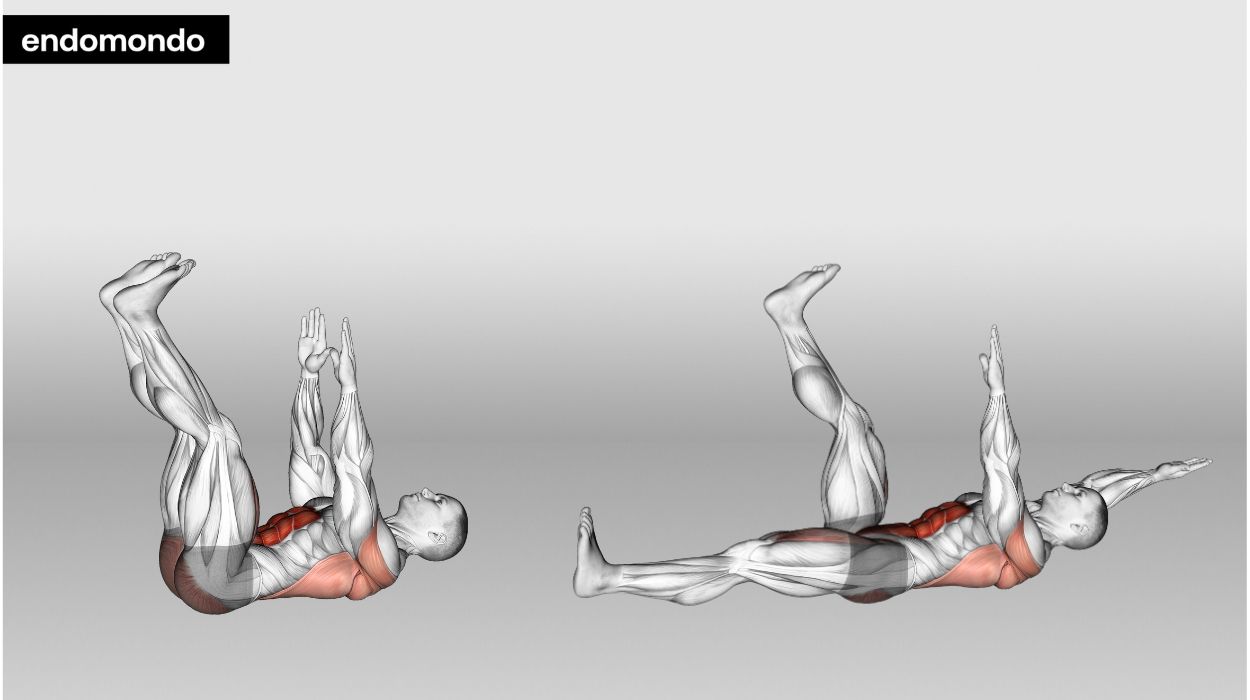
How to do:
- Lie on your back with your arms extended towards the ceiling and knees bent at a 90-degree angle.
- Lower your right arm and left leg towards the floor without touching it.
- Return to the starting position and repeat on the other side.
Tips:
- Maintain a neutral spine by pressing your lower back into the floor during the dead bug exercise to engage the deep core muscles effectively.
- Coordinate your breathing with the movement – exhale as you extend your arm and leg and inhale as you return to the starting position.
- Keep your core engaged throughout the exercise to stabilize your spine and prevent arching your back.
Optimal Sets and Reps: 2 to 3 sets of 10-12 reps on each side.
Russian Twist
The Russian Twist targets your obliques, which are your side abdominal muscles. These muscles support your posture and your breathing.
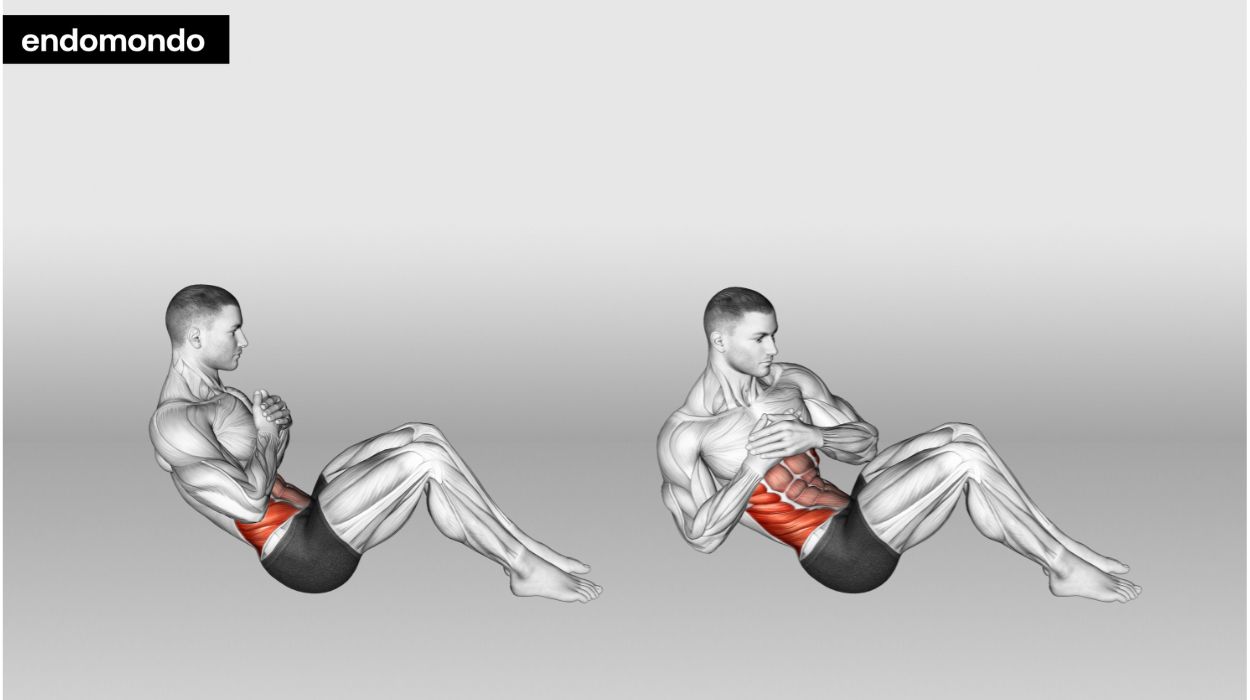
How to do:
- Sit on the ground with your knees bent and heels flat on the floor, hands on your chest
- Lean back slightly and lift your feet off the ground, balancing on your sit bones.
- Rotate your torso to the right and then to the left.
- Repeat for the desired number of repetitions.
Tips:
- Sit tall and maintain a straight back to avoid slouching during the Russian Twist. Engage your core muscles and twist your torso from the waist to work the obliques effectively.
- Exhale as you twist to each side, focusing on deep-core engagement. Keep your feet off the ground for an added challenge.
- Gradually increase the reps as you build strength. Ensure controlled movements and proper form throughout.
Optimal Sets and Reps: 3 sets of 10 reps on each side.
Bird Dog
The Bird Dog exercise is a great way to improve your balance and core stability. It also engages your back muscles. It improves balance and coordination and strengthens the core muscles. This exercise can be done anywhere, without any equipment.
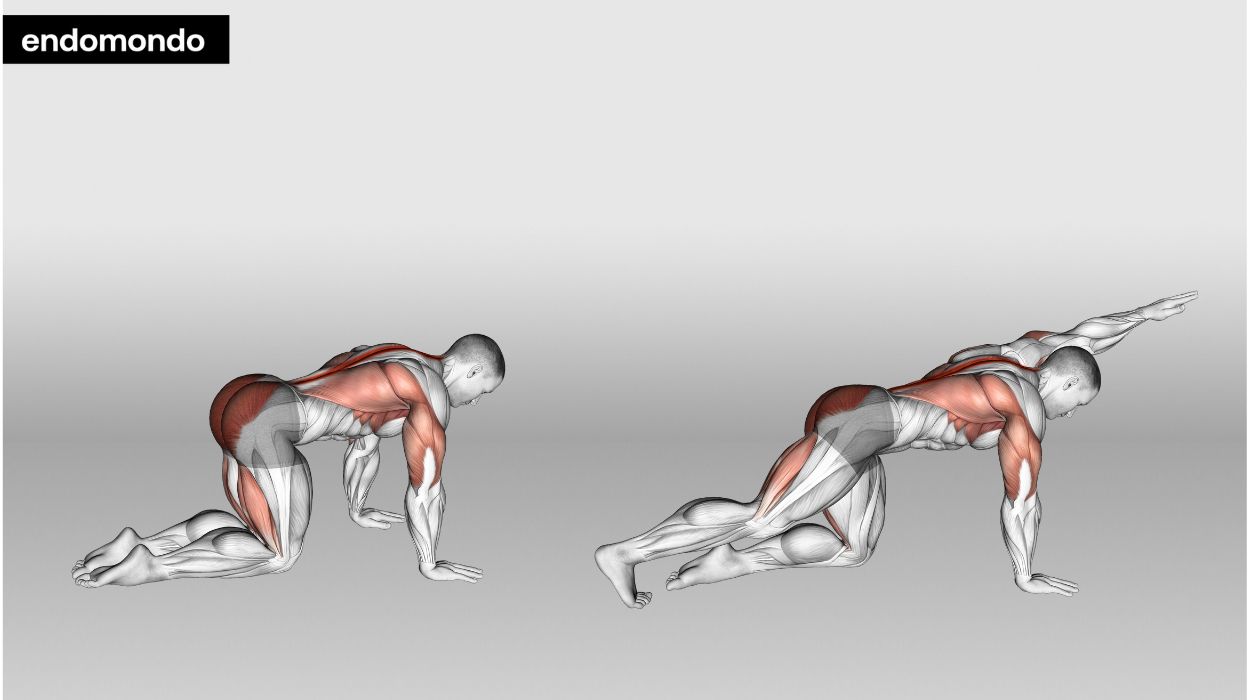
How to do:
- Get on the mat and start on all fours with your hands under your shoulders and knees under your hips.
- Extend your right arm forward and left leg backward, keeping them parallel to the floor.
- Hold momentarily, then return to the starting position and switch sides.
Tips:
- Begin in a tabletop position with your wrists aligned under your shoulders and knees under your hips. Keep your spine neutral, engage your core, and avoid overarching or rounding your back.
- Focus on balance and stability as you extend one arm and the opposite leg simultaneously. Exhale as you reach, maintaining a straight line from fingertips to toes. Avoid any jerky or uncontrolled movements.
- Maintain proper form and controlled movements throughout to target your deep core muscles effectively.
Optimal Sets and Reps: 3 sets of 10 to 12 reps per side.
Bicycle Crunch
The Bicycle Crunch is an effective move for targeting your rectus abdominis and obliques. Strength training exercises like these have been shown to improve metabolic markers,[1] such as body composition, blood pressure, inflammation, and blood glucose levels.
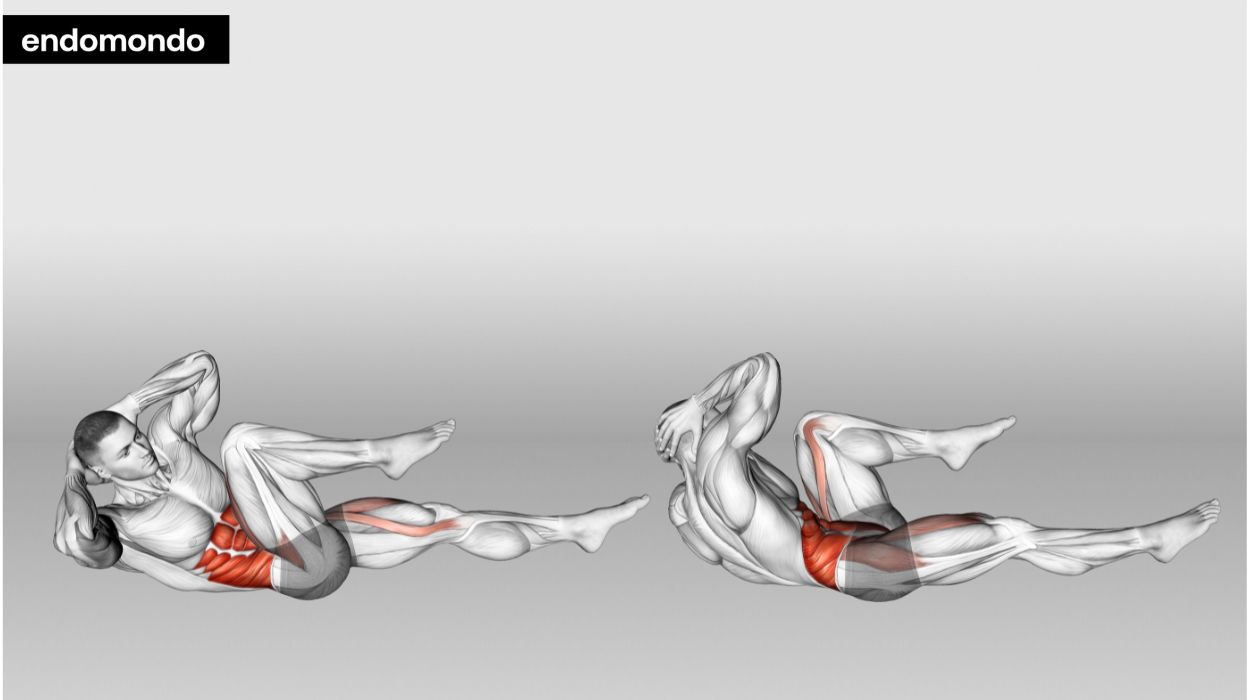
How to do:
- Lie on your back with your hands behind your head and knees bent.
- Crunch up as you bring your right elbow towards your left knee and simultaneously straighten your right leg.
- Switch sides and repeat in a cycling motion.
Tips:
- As you perform the bicycle crunch, focus on bringing your opposite elbow and knee toward each other, twisting your torso.
- Breathe consistently throughout the exercise, exhaling as you crunch and inhaling as you extend your leg. Avoid straining your neck and lower back by keeping your movements controlled and your core engaged.
- Maintain proper form and a smooth, bicycle-like motion to effectively engage your deep core muscles.
Optimal Sets and Reps: 3 sets of 10 to 15 reps on each side.
Lying Leg Raise
The Lying Leg Raise exercise targets the lower abs and hip flexors, helping to strengthen the lower core. This targets an area where many people want to burn fat. Spot reduction doesn’t usually work, but focusing on the target area can still bring improvement.
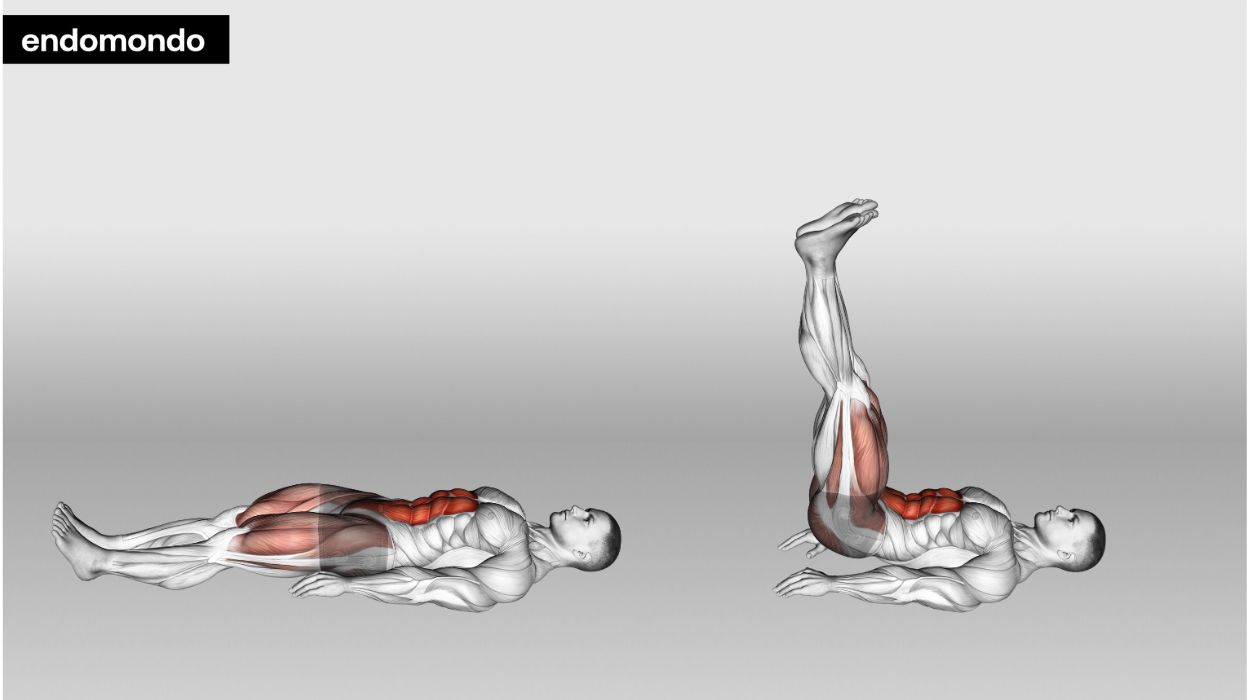
How to do:
- Lie on your back with your hands under your hips and legs extended.
- Slowly raise your legs towards the ceiling, keeping them straight.
- Lower them back down without touching the floor and repeat.
Tips:
- Maintain proper form by keeping your lower back pressed into the floor throughout the exercise to protect your spine and engage your deep core muscles effectively.
- Exhale as you lift your legs and inhale as you lower them, coordinating your breath with the movement for better control and core engagement.
- Avoid swinging or using momentum to lift your legs; focus on slow and controlled movements.
Optimal Sets and Reps: 3 sets of 12 to 15 reps.
Swiss Ball Pike
Using a Swiss ball intensifies this exercise by adding instability. Your core must constantly work to keep you balanced. The ball also allows you to move in different ways than a flat surface, improving your range of motion and flexibility.
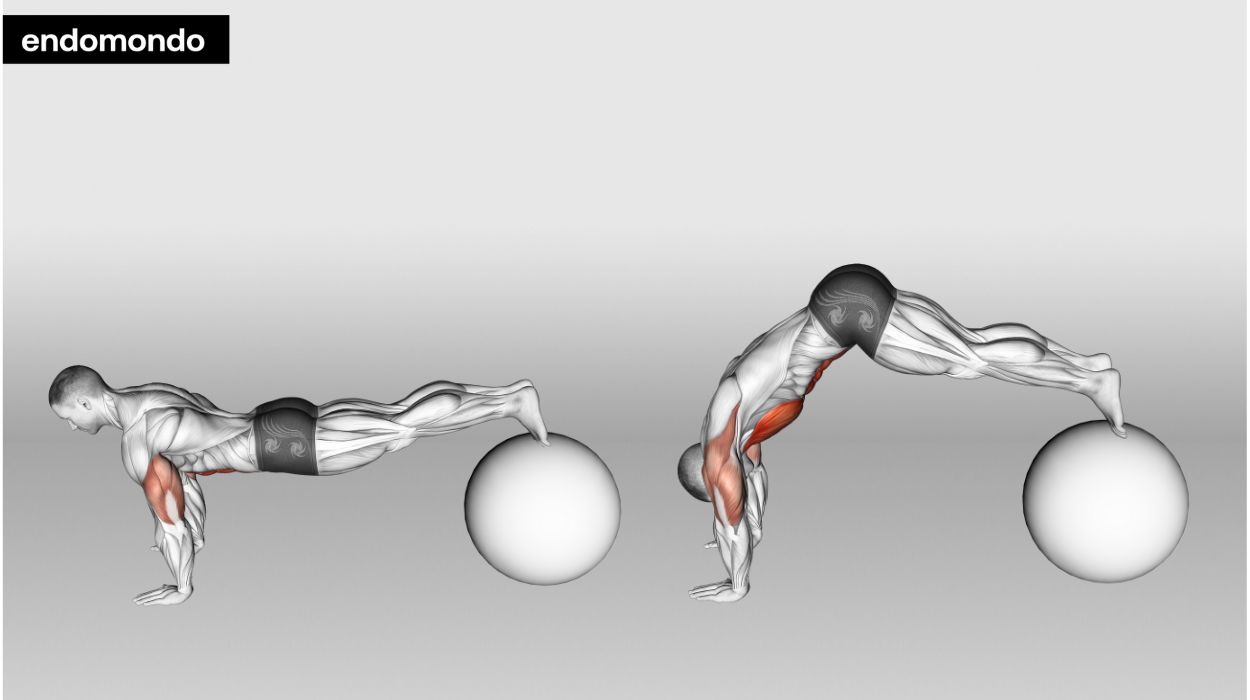
How to do:
- Start in a push-up position with your feet on a Swiss ball.
- Engage your core and lift your hips, rolling the ball towards your chest.
- Slowly roll the ball back to the starting position and repeat.
- Perform 8 to 10 reps.
Tips:
- Maintain proper form by starting in a plank position with your hands on the floor and your feet on the Swiss ball, creating a straight line from head to heels.
- Exhale as you lift your hips and roll the ball towards your chest, engaging your deep core muscles. Inhale as you return to the starting position.
- Avoid arching your back or letting your hips sag; focus on a controlled and smooth movement.
Optimal Sets and Reps: 3 sets of 10-12 reps.
Side Plank
The Side Plank works the obliques and helps stabilize the core from the sides.
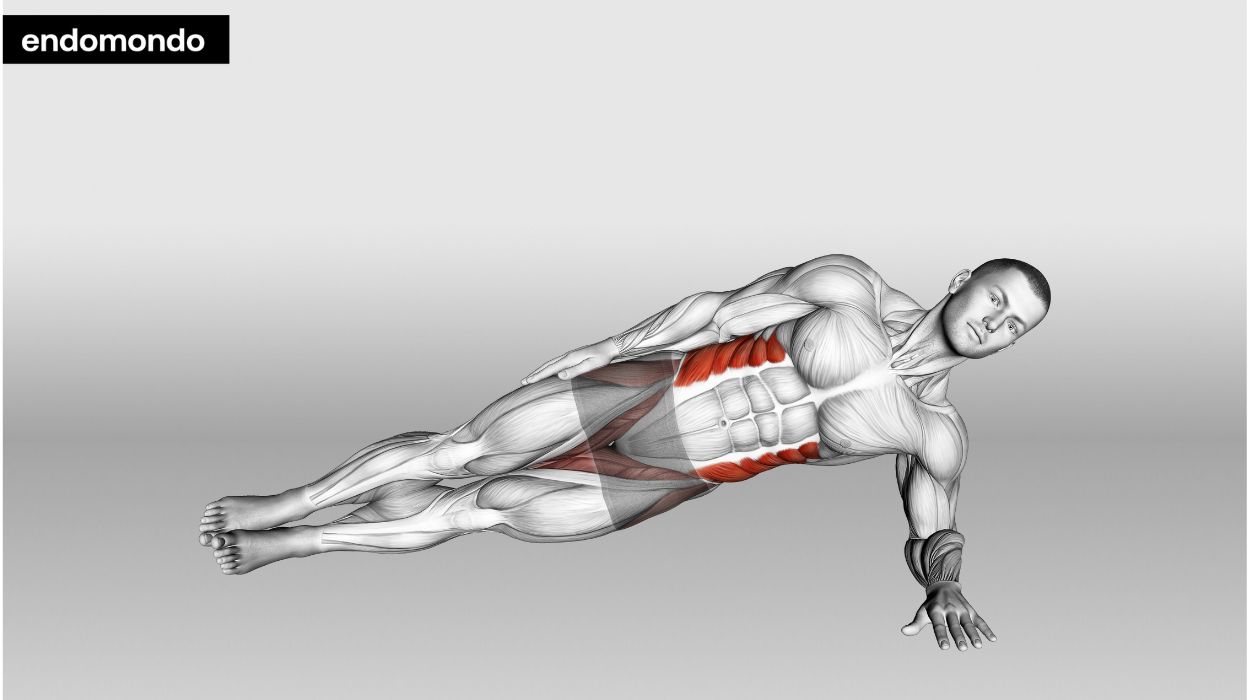
How to do:
- Lie on your side with your elbow directly beneath your shoulder and your legs stacked on top of each other.
- Lift your hips, creating a straight line from head to heels.
- Hold for the desired time on each side.
Tips:
- Ensure proper form by lying on your side with your elbow directly beneath your shoulder and your legs stacked on top of each other. Keep your body in a straight line from head to heels.
- Focus on your breathing; inhale deeply through your nose and exhale slowly through your mouth while holding the side plank position. Avoid letting your hips drop or lifting them too high.
Optimal Sets and Reps: 3 sets of 20-30 seconds on each side.
Mountain Climbers
The Mountain Climbers routine targets your core and provides a cardiovascular element to your deep core workout. This rapid-moving exercise is great for weight loss and trimming fat.
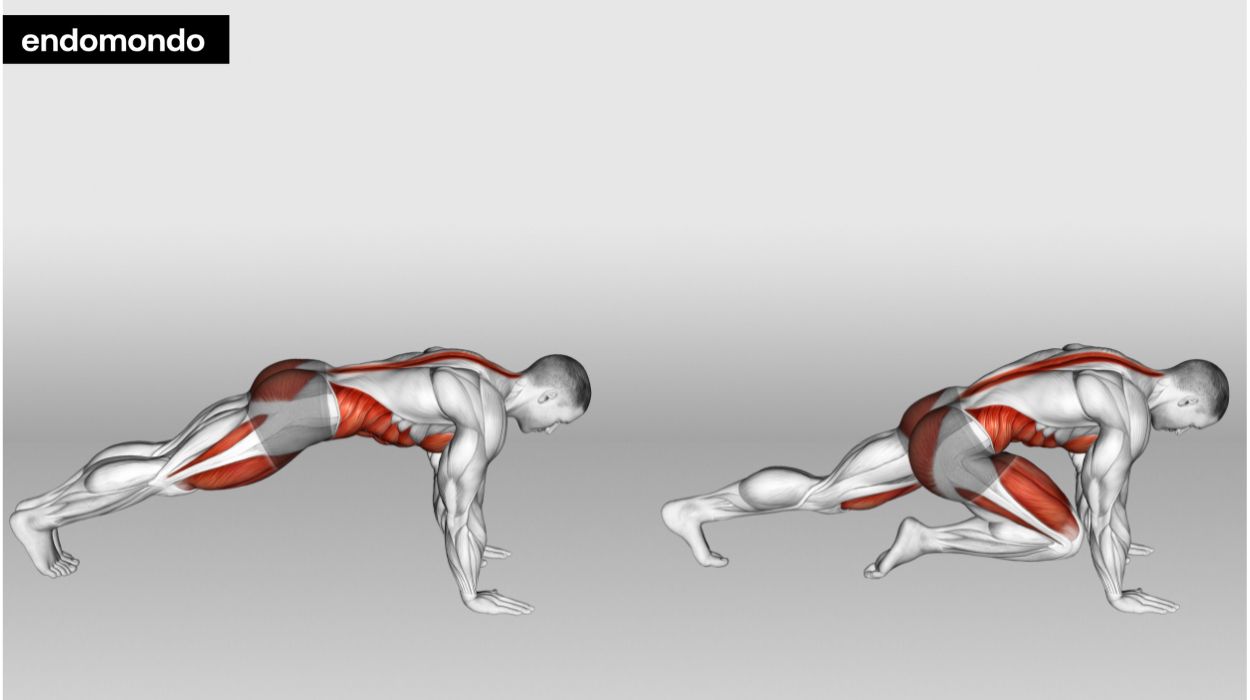
How to do:
- Begin in a plank position with your arms straight.
- Bring your right knee towards your chest, then quickly switch legs.
- Continue alternating legs in a running motion for 30-60 seconds.
Tips:
- Maintain a plank position with your hands directly under your shoulders and engage your core throughout the exercise to protect your lower back.
- Breathe rhythmically by inhaling and exhaling with each knee drive, keeping your movements controlled and your hips stable.
- Perform mountain climbers at a moderate pace for optimal core engagement and cardiovascular benefits.
Optimal Sets and Reps: 3 sets of 30 seconds, gradually increasing the duration to 60 seconds per set.
Reverse Crunch
The Reverse Crunch is a great lower ab workout that engages your entire core. Exercises like these, which move multiple muscles, help build your strength more than exercises that only use one.
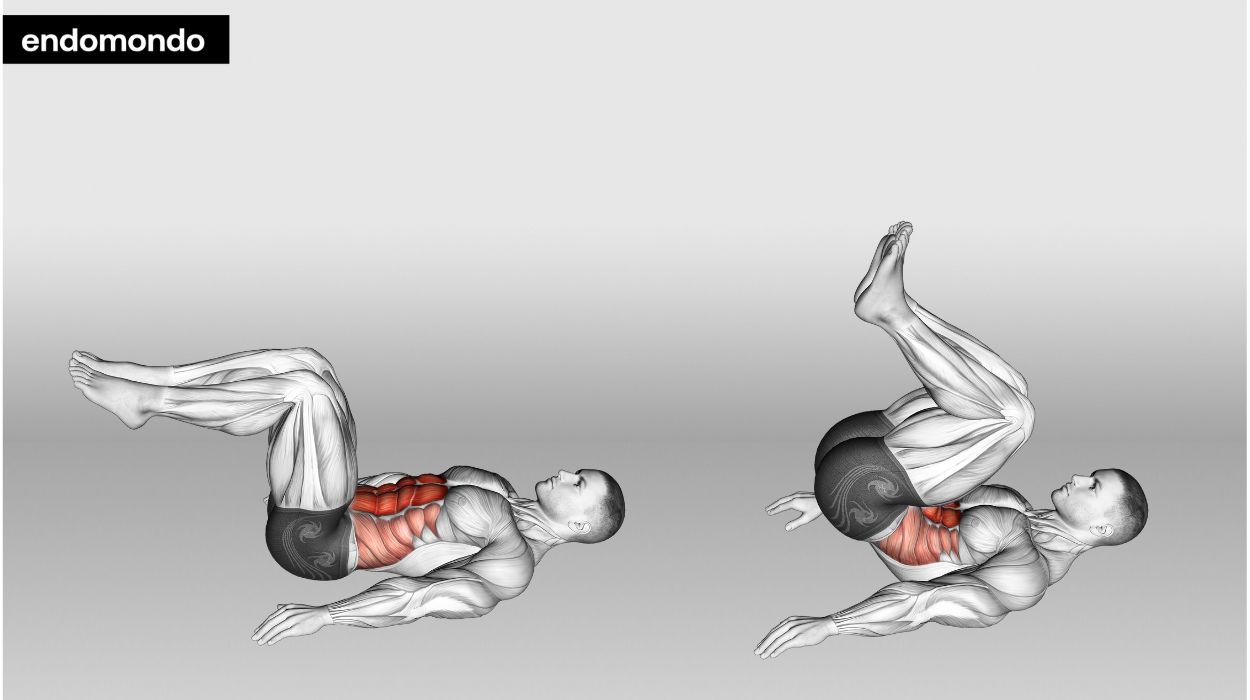
How to do:
- Lie on your back with your hands by your sides, legs lifted towards the ceiling, and knees bent.
- Curl your hips off the floor, bringing your knees towards your chest.
- Slowly lower your legs back to the starting position and repeat.
Tips:
- Keep your lower back pressed firmly into the floor throughout the movement to ensure you’re targeting the lower abs and avoiding strain on your back.
- Exhale as you lift your hips off the ground and inhale as you lower them down, maintaining controlled breathing to engage your core effectively.
- Focus on precise and controlled movements for the best results in strengthening your deep core muscles.
Optimal Sets and Reps: 3 sets of 12 to 15 reps.
Benefits Of Deep Core Exercise
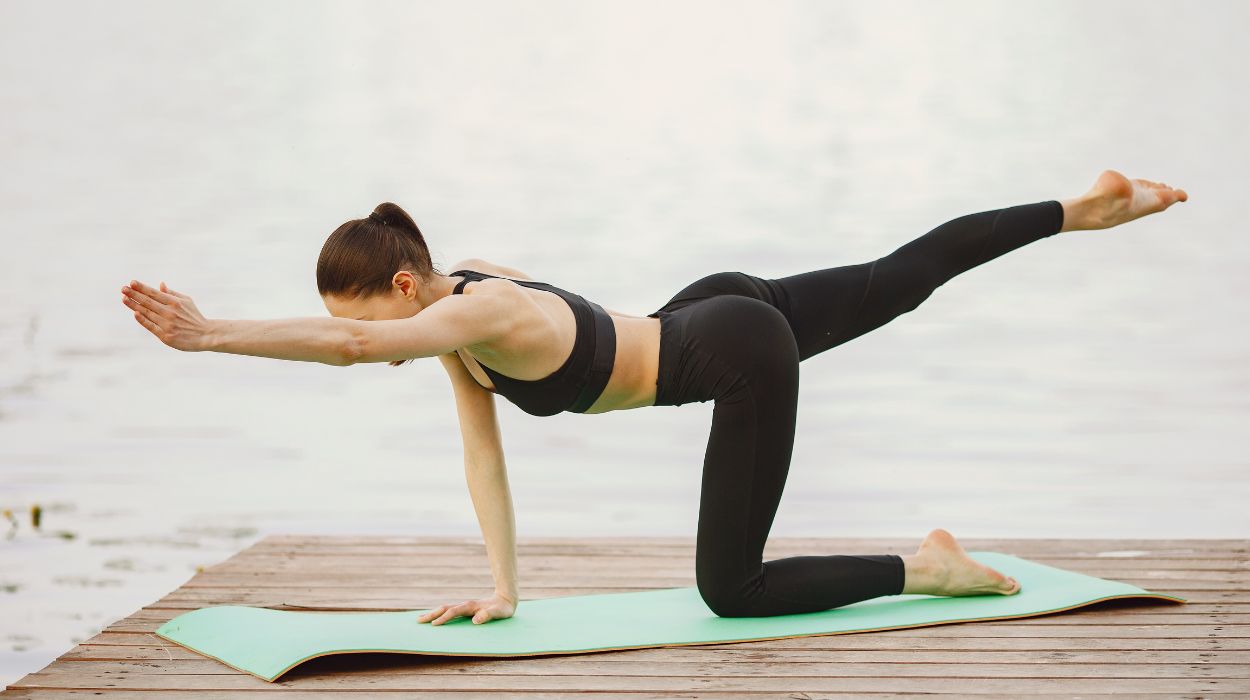
Improved Core Strength And Stability
Deep core and pelvic floor exercises specifically target the muscles deep within your abdomen, such as the transverse abdominis and pelvic floor muscles. By strengthening these muscles, you enhance the foundation of your core, leading to improved stability and balance.
This, in turn, benefits your overall performance in various physical activities and sports, reducing the risk of injuries and enhancing your body’s ability to move efficiently. Muscle-building isn’t just for looks; it makes you healthier and better able to perform even everyday tasks.
Reduced Risk Of Back Pain
A strong core supports your spine and lower back. Engaging in exercises for your core and abs will help alleviate stress on the lumbar region,[2] which promotes proper alignment and reduces the likelihood of back pain.
Better Posture And Body Alignment
Pelvic floor and deep core exercises contribute to better posture[3] by strengthening the muscles responsible for supporting your spine and pelvis. As your core strengthens, you’ll find it easier to maintain a straight line from head to heels in various activities.
Good posture prevents strain on your back, projects confidence, and improves overall body alignment.
Tips To Avoid Injury
- Rest between workout sessions, especially those that involve the hardest core exercises. It is actually possible to exercise too much.[4]
- Focus on proper form and alignment during each exercise.
- Start with lower reps and gradually increase intensity as you get stronger.
- Make sure to warm up[5] before beginning any exercise.
- Engage your core muscles throughout the workout to maintain stability.
- Pay attention to the nutrients you need for energy and muscle-building.
- Listen to your body and avoid pushing yourself too hard, especially if you’re a beginner.
- Consider consulting with a corrective exercise specialist for personalized guidance.
Conclusion
Deep core exercises are valuable to any fitness routine. They strengthen your core muscles and contribute to improved overall body strength and stability, improved posture, and reduced risk of back pain and injury.
Strength training also helps to improve body composition,[6] blood pressure, lipid profiles, and blood sugar levels. Incorporate these exercises into your workouts regularly and pair them with a balanced diet to maximize your results in weight loss, muscle-building, and core strength.
When doing deep core exercises, it is important to maintain proper form and take breaks when needed to avoid injury. Remember, consistency is key when it comes to getting results. Aim to do deep core exercises at least three to four times weekly and pair them with a healthy diet and regular cardio for optimal results.
Frequently Asked Questions
Aim for at least two to three sessions of core strengthening exercises per week. Take at least one day of rest in between to allow your muscles to recover and grow. Regular workouts are important to get enough physical activity.[7]
Yes, planks are actually one of the best deep-core muscle exercises. They work every part of the core. In addition, they’re a type of resistance training[8] that has been shown to prevent injuries and speed recovery.
While exercises for deep core muscles contribute to overall core strength and stability, targeted fat burning is best achieved through a combination of a balanced diet that potentially includes supplements, cardio exercises, and a full-body workout routine.
Russian twists, dead bugs, lying leg raises, and side planks are some of the best deep-core beginner exercises.
Resources
- Ihalainen, J.K., Inglis, A., Tuomas Mäkinen, Newton, R.U., Heikki Kainulainen, Heikki Kyröläinen and Walker, S. (2019). Strength Training Improves Metabolic Health Markers in Older Individual Regardless of Training Frequency. Frontiers in Physiology, [online] 10. doi:https://doi.org/10.3389/fphys.2019.00032.
- Chang, W., Lin, H. and Lai, P.-T. (2015). Core strength training for patients with chronic low back pain. Journal of Physical Therapy Science, [online] 27(3), pp.619–622. doi:https://doi.org/10.1589/jpts.27.619.
- Kim, D.-J., Cho, M., Park, Y. and Young Il Yang (2015). Effect of an exercise program for posture correction on musculoskeletal pain. Journal of Physical Therapy Science, [online] 27(6), pp.1791–1794. doi:https://doi.org/10.1589/jpts.27.1791.
- Medlineplus.gov. (2023). Are you getting too much exercise?: MedlinePlus Medical Encyclopedia. [online] Available at: https://medlineplus.gov/ency/patientinstructions/000807.htm.
- Park, H.-K., Jung, M.-K., Park, E., Lee, C.-Y., Jee, Y.-S., Eun, D., Cha, J.-Y. and Yoo, J. (2018). The effect of warm-ups with stretching on the isokinetic moments of collegiate men. Journal of exercise rehabilitation, [online] 14(1), pp.78–82. doi:https://doi.org/10.12965/jer.1835210.605.
- Ihalainen, J.K., Inglis, A., Tuomas Mäkinen, Newton, R.U., Heikki Kainulainen, Heikki Kyröläinen and Walker, S. (2019). Strength Training Improves Metabolic Health Markers in Older Individual Regardless of Training Frequency. Frontiers in Physiology, [online] 10. doi:https://doi.org/10.3389/fphys.2019.00032.
- CDC (2023). Physical Activity Basics. [online] Centers for Disease Control and Prevention. Available at: https://www.cdc.gov/physicalactivity/basics/index.htm.
- Fernandes, J., Lamb, K.L. and Twist, C. (2019). Exercise-Induced Muscle Damage and Recovery in Young and Middle-Aged Males with Different Resistance Training Experience. Sports, [online] 7(6), pp.132–132. doi:https://doi.org/10.3390/sports7060132.




